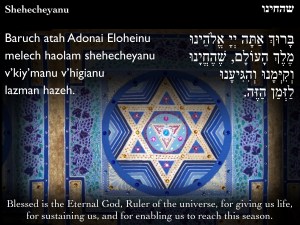I am honored and excited to be the new editor at the CCAR Press. Under the leadership of Rabbi Hara Person, I will be listening to your ideas, reading what your write, and working with you to create books, apps, and online learning opportunities!
Think about me as your editor, liturgist, and teacher.
As I did for the last six years, I will spend the upcoming High Holidays at a JCC in Chevy Chase-Bethesda, Maryland, where I work as a cantorial soloist. Each year, I deliver the sermon on Erev Rosh haShanah. This is a snippet of the (oh, too many words) I am going to share on that Bimah:
I, personally, try to laugh that laughter more often these days. It’s a laughter that is forgiving towards myself, towards the human beings around me, and towards this entire mess of our chaotic world. I try to internalize that all we have is a little Torah (a book written after all, on the skin of a dead cow) in order to help us figure out together the nature of this mystical creation, and write together the Torah of our lives, Torat Hayim, the Torah of Life, a living Torah.
In other moments, I, like so many others, grow impatient, and then I write poems (S. Pilz (2018): Creation. Unpublished.) like this one:
Creation: Fed up with Tohu
What if in the beginning
Something did get consumed?
With black coal a universe got written
Dancing, twisting, whimpering, crawling,
What if in the beginning,
Something was broken.
You and I, we shine together.
What if we were to learn
How to calmly tame our fire?
Will we then crush gently,
And rise,
With a kiss?
Most of our time on earth, it seems to me, gets spent trying to figure out how to live this life right here and now. We are getting used to ourselves and to others. We build relationships, co-creating our own entire little universes. This way, all of us re-create and change the world in every single second. This, now, is a moment when the world gets re-created by us. And now. At every single moment of our lives.
And in these moments, as all of us are sitting here together, creating a universe of prayer, Torah, singing, learning, the order of prayer, reflection, and beauty, I want to share yet another poem with you, a second poem by the American writer Mary Oliver (M. Oliver (1992): New and Selected Poems, from “The Summer Day”, p. 94.) who wrote the poem with which I opened my sermon:
I don’t know exactly what a prayer is.
I do know how to pay attention, how to fall down
into the grass, how to kneel down in the grass,
how to be idle and blessed, how to stroll through the fields,
which is what I have been doing all day.
Tell me, what else should I have done?
Doesn’t everything die at last, and too soon?
Tell me, what is it you plan to do
With your one wild and precious life?
—
Rabbi Sonja K. Pilz earned a doctorate from the department of Rabbinic Literature at Potsdam University, Germany; she holds Rabbinic Ordination from Abraham Geiger College, Germany. Prior to joining the CCAR Press as editor, Sonja taught Jewish liturgy, worship, and ritual at HUC-JIR, NY; the School of Jewish Theology at Potsdam University; and in many congregational settings. She served as a visiting rabbi and cantorial soloist in congregations in Germany, Switzerland, Israel, and the US.





 During the second and third year’s planning meetings, I fretted that many of those booklets had not returned to us. I was concerned about the potential chilul of where those booklets might have ended up and about the environmental waste of resources that would not be re-used and possibly not recycled. I wanted to revise some of the language we had chosen, but didn’t want to get rid of all the books we still had on hand. Some time between the third and fifth year I encountered
During the second and third year’s planning meetings, I fretted that many of those booklets had not returned to us. I was concerned about the potential chilul of where those booklets might have ended up and about the environmental waste of resources that would not be re-used and possibly not recycled. I wanted to revise some of the language we had chosen, but didn’t want to get rid of all the books we still had on hand. Some time between the third and fifth year I encountered 







